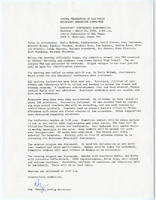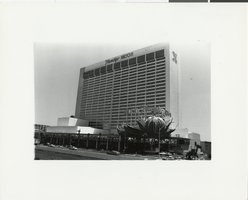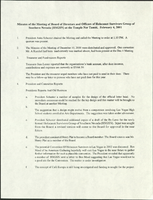Search the Special Collections and Archives Portal
Search Results

Transcript of interview with Peter Perazzo by Claytee White, July 22, 2016
Date
Archival Collection
Description
Peter Perazzo, a land surveyor born and raised in Las Vegas, talks about his family, his Native American ancestry, and how construction and land surveying have changed over the years. Peter’s father, Frederick Perazzo, moved temporarily to Las Vegas from Reno in the 1940s to find employment. He worked as a draftsman, and later an architect. He designed public building and residential buildings around the valley as well as at Area 51 (Atomic Test Site). His temporary move became permanent in 1953 with the purchase of a family home in Northwest Las Vegas, across from Twin Lakes. Peter’s early life was spent playing in clover in the family’s yard and enjoying his four grandmothers. Peter began his land surveying career working for the Bureau of Land Management (BLM) in 1985. He describes how he became hooked on the profession and describes surveying terms like monuments, townships, and “the dumb end of the tape”. Later Peter worked for the Nevada Department of Transportation, where he wa
Text
Ida M. Gaines oral history interview
Identifier
Abstract
Oral history interview with Ida M. Gaines conducted by Claytee D. White on September 30, 2016 for the African Americans in Las Vegas: a Collaborative Oral History Project. In this interview, Gaines discusses her early life in Louisiana. She recalls moving to Las Vegas, Nevada in 1959, living in the Westside, and her employment at the Nevada Test Site. Gaines remembers integration, her involvement with the Las Vegas Chapter of The National Association for the Advancement of Colored People (NAACP), and becoming a member of Gamma Phi Delta. Gaines talks about working with Senator Harry Reid as a community liaison, the economic downfall of Jackson Street businesses, and redevelopment of the Westside. Lastly, Gaines discusses the issue of homelessness in the community, and the work that the Economic Opportunity Board (EOB) did to reduce poverty in the Westside.
Archival Collection
Morse Arberry oral history interview
Identifier
Abstract
Oral history interview with Morse Arberry conducted by Brittany Thompson and Andrew Thomas on November 20, 2015 for the African Americans in Las Vegas: a Collaborative Oral History Project. In this interview, Arberry discusses his personal history and moving to Las Vegas, Nevada in 1958. He talks about his father's employment at the Nevada Test Site and the issues of segregation at the time. Arberry recalls attending the Westside School and talks about school integration. He then describes his career in legislation, working on bills to improve the integration process, and the impact that the University of Nevada, Las Vegas (UNLV) had on the level of education among adults in the community. Lastly, Arberry discusses the West Las Vegas community, the significance that religion had on African Americans, and the increase of law enforcement in the area.
Archival Collection
Betty Ham Dokter Photograph Collection
Identifier
Abstract
The Betty Ham Dokter Photographs depict the Ham Family from 1850 to 1976. The materials include photographs of the family after they moved to Las Vegas, Nevada in 1916 and document the early growth of the city. The materials also include photographs of the Colorado River, the Hoover (Boulder) Dam site before and after its construction, dinner parties, family photographs, and citizens of the Las Vegas area. The materials also include photographs of Alta Mereness Ham, Betty Ham Dokter's mother, on the set of the film Water.
Archival Collection

Newspaper article, Pioneer Las Vegan Sees Town Grow, Las Vegas Sun, February 9, 1965
Date
Archival Collection
Description
Newspaper article featuring Lucretia Stevens. She moved to Las Vegas in 1923 when the town was about six blocks square and about 60 people made up the black community.
Text

Meeting Minutes from the Jewish Federation of Las Vegas Holocaust Education Committee Educators' Conference Subcommittee, March 22, 1994
Date
Archival Collection
Description
Meeting Minutes from the Jewish Federation of Las Vegas Holocaust Education Committee Educators' Conference Subcommittee.
Text

The Boulder Dam Las Vegas Rotary Club newsletter, September 30, 1926
Date
Archival Collection
Description
Text

Photograph of the front exterior of the Flamingo Hilton (Las Vegas), circa 1979
Date
Archival Collection
Description
Flamingo Hilton circa 1979
Site Name: Flamingo Hotel and Casino
Address: 3555 Las Vegas Boulevard South
Image

